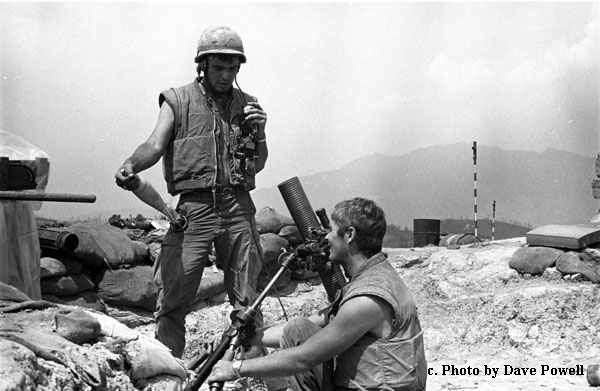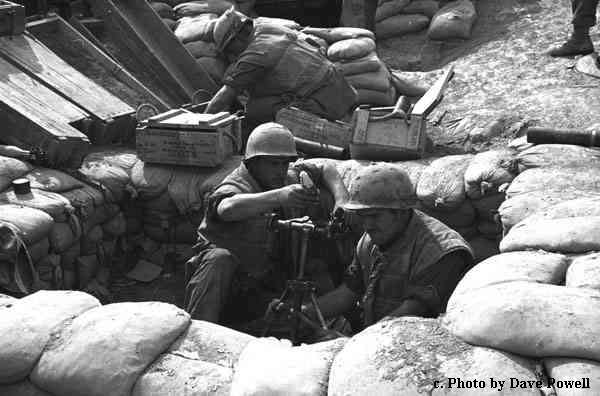 |
 |
 |
 |
 |
 |
Hill 881S had a section of two 81mm mortars manned by approximately 20 of the best mortarmen in the Marine Corps, certainly the most experienced. They did all our longer-range Close Air Support (CAS) marking and in coordination with our Forward Air Controller (FAC) could time a round to hit target at the instant CAS bird came "wings-level" on bombing run, did it almost daily when weather allowed.
Close-in target marking was done with 60mm mortar. Shorter range than 81s, but had the advantage of 'direct lay', that is, gunner could see his target and make his own adjustments. Crews equally good after a few weeks on the hill, fired 50-100 rounds a day when we could see. NVA would move in close to us at night to avoid artillery and B-52 strikes, so 60mm mortars would fire constantly at night to brush them off, 'walking' rounds around hill in random patterns. We tried to follow the '100-to-one' rule, that is, for every round fired at us, we'd fire 100 back, and 60s were a major part of that.
The 60mm gunners were also very quick and responsive. A FAC(A) called one day to say he'd spotted an NVA soldier in a tree about 1,000 meters south of us, said he had no strike aircraft, asked if we could bring fire to bear. 60s crew could see FAC(A) marking round, fired an HE round and asked for adjustment, FAC(A) called, "Cease Fire." Said they'd hit tree, dropped NVA with first round!
Strangest mission involved both 60s and 81s. About 0200 one clear night, the whole area north of us lit up, we called Khe Sanh Combat Base (KSCB) and other outposts to find out what was going on, they said they didn't know and were not shooting. NVA were shooting illumination rounds? We were perplexed, since NVA never used illum, but 1stLt. Chuck Schneider pointed out that all illum was north of us, as if someone south were trying to outline our hill. We started firing illum from all mortars too, randomly 360 degrees around hill, lots of it, at various ranges. Both we and NVA kept it up for about fifteen minutes, then they stopped, so we stopped. Got real dark, everybody night-blind. Got real quiet, too. Suddenly there was a loud noise going close over us from south to north, sounded like an express subway train going full-bore past the platform you're standing on, then a horrendous explosion about 800 meters north of us, then quiet again. Nothing more. I think to this day that 881S was the intended recipient of a Russian ground-to-ground SCUD-type missile. They missed.
One night of 20 or 21 Jan. '68, Hill 861 was assaulted by NVA, broke through wire, Marines were in hand-to-hand fight in trenches in dark and fog. Was told later by a Hill 861 Marine they couldn't see to tell friend from foe, so anyone who came toward them was beaned on the head with entrenching tool. If it was a Marine, no problem, since Marines were wearing steel helmets. The NVA wore cardboard pith helmets, good beaning killed 'em or at least knocked them out.
The Commanding Officer on Hill 861 called for mortar support from 881S, said NVA were coming up northwest slope of his hill which masked them from supporting guns down at KSCB. Our mortarmen fired 700 rounds in about three hours sealing the breach while the 861 Marines cleared hill of NVA penetrators. No way could 20-man 81mm section break out that many rounds fast enough, had to assign whole infantry platoon to break out rounds for them. Ground in mortar pits was clay, range to back side of Hill 861 was about 3,300 meters, which meant maximum charge. As guns fired, base plates would sink into clay to point where gunners could no longer see lighted aiming stakes, had to cease fire and dig out/sand bag under base plates because accuracy was critical. It was a "danger-close" mission only 100-200 meters forward of 861's lines.
After about 50 rounds per tube, tubes got so hot they were glowing in the dark, charge increments were igniting as round slid down tube, round would shoot out prematurely, go God knows where down range. We had to cool the tubes, used fruit juice from some cans of it we had stashed on hill. Ran out, used water 'till we ran out of all we had that was not in troop's canteens. Finally lined up troops by platoon and had 'em urinate on tubes. Smelled awful, but got the job done!
When Hill 861Alpha was assaulted on 7 Feb. '68, scenario repeated, range about the same, used same system, fired close to 1,000 rounds that night - from two tubes! Tubes were probably bored out to about 82-83mm by time the siege ended. Hell of a gun section!
Submitted by:
William H. "Bill" Dabney, Colonel
USMC(Ret)